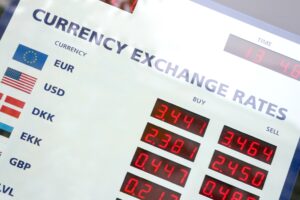Currency exchange rates shape economies, business decisions, and personal budgets worldwide. Yet many people do not understand how they work. Whether you travel abroad, run an import/export business, or shop online, exchange rate fluctuations change what you pay. Prices rise or fall as currencies strengthen or weaken in the foreign exchange market.
Rates move with supply and demand. They also respond to interest rates, inflation, growth, trade balances, capital flows, and risk sentiment. Policy choices and geopolitical events add further momentum. Understanding these drivers helps you plan better and avoid costly surprises.
This guide explains why currency exchange rates change, what forces create those shifts, and how they link to the global economy. You will see how quotes work, what moves major pairs, and how simple tactics can reduce currency risk.
What Are Currency Exchange Rates?
A currency exchange rate is the price of one currency in another. If 1 US dollar equals 83 Indian rupees, the rate is 1 USD = 83 INR. Rates move constantly as buyers and sellers interact in the foreign exchange market.
Each quote shows a base and a quote currency. In USD/INR, USD is the base and INR is the quote. A price of 83.00 means one US dollar costs eighty three rupees. Markets display a bid and an ask. The bid is where you can sell the base. The ask is where you can buy the base. The gap is the spread.
Most pairs move in pips. A pip is the fourth decimal place for most pairs. For JPY pairs, it is the second decimal place. If USD/INR moves from 83.0000 to 83.0100, that is a 10 pip move.
The foreign exchange market, or Forex, is the world’s largest financial market. It runs 24 hours a day during the business week. There is no single central exchange. Trading occurs over the counter through banks, brokers, and electronic networks. Participants include banks, funds, corporations, and individual traders. They buy and sell currencies in response to news, data, and capital flows.
Exchange rate fluctuations reflect supply and demand. Demand rises when investors or importers need a currency. Demand falls when they sell or shift to alternatives. These shifts affect travel costs, online purchases, and global trade every day. Understanding how quotes work and why they move helps you plan better and avoid costly surprises.
The Role of Supply and Demand in Currency Value
Currency value rises when demand outpaces supply and falls when selling pressure dominates. In the foreign exchange market, this balance shifts constantly as trade, investment, and hedging flows hit the book. Demand for a currency means investors, companies, tourists, or remitters want to hold it. For example, if global funds buy Indian government bonds, they first purchase rupees. That extra demand can lift the rupee’s exchange rate. Supply means market participants are willing to sell the currency. An Indian refiner paying for oil in US dollars sells rupees to buy dollars, which adds rupee supply and can weaken INR.
Price changes occur at the margin. When buy orders consume available offers, the price ticks higher. When sell orders hit bids faster than new buyers appear, the price moves lower. Deep, liquid pairs absorb the same flow with smaller moves, while thinner pairs move more on equal flow. The mix of flows also matters. Temporary items like month-end hedging, seasonal travel, or dividend payments may push rates briefly. Structural forces such as persistent trade surpluses, long-term foreign direct investment, and credible policy shifts can guide the trend in currency value.
Expectations shape today’s price as much as current flows. If a central bank is likely to raise rates, investors may buy the currency ahead of the decision. If policy credibility slips, sellers can appear before any headline. In simple USD/INR terms, more buyers of INR than sellers usually means INR appreciation and a lower USD/INR quote. More sellers than buyers usually means INR depreciation and a higher USD/INR quote.
Common misconceptions cloud the picture. Money supply alone does not set the rate. It is the real-time balance of willing buyers and willing sellers. Central banks can influence or smooth moves through intervention, but they do not fully control the market when fundamentals point the other way.
The impact reaches daily life. A weaker home currency raises import costs and travel expenses but can improve export revenues and tourism receipts. Debt service in foreign currency also changes as the exchange rate moves. Understanding who is buying, who is selling, and why turns supply and demand from a slogan into a practical lens for reading currency moves.
How Interest Rates Impact Currency Exchange Rates
Interest rates play a major role in shaping currency exchange rates. When a country raises its interest rates, foreign investors move their money there. They seek higher returns, which requires converting their currency into the local one. This increases demand for that country’s currency and strengthens its exchange rate.
Let’s say the US Federal Reserve raises its interest rates. Investors start buying US dollars to earn better returns. As a result, the dollar becomes stronger in the foreign exchange market.
Alternatively, if India cuts interest rates, foreign investors might withdraw their funds. That creates downward pressure on the rupee’s value and weakens its currency exchange rate.
The Connection Between Economic Performance and Currency Value
Strong economic performance increases confidence in a country’s currency. Investors want to put their money where growth is visible and stable. High employment, GDP growth, rising exports, and increasing business investments indicate a healthy economy.
When a nation experiences economic growth, its currency exchange rate often rises. On the contrary, weak economic data leads to lower investor confidence. That triggers capital outflows and weakens the currency.
For example, if Japan reports high GDP growth and innovation in technology, more investors want to buy yen. They trust that the currency will retain or grow in value. This increase in demand strengthens the yen’s exchange rate.
Political Stability and Market Sentiment Also Influence Currency Exchange Rates
Currency markets are highly sensitive to political changes. Stable governments attract foreign investors, boosting currency value. However, political instability causes panic and capital flight.
In 2016, when the UK voted for Brexit, the British pound crashed overnight. There was no immediate economic downturn, but fear drove investors away. Currency exchange rates dropped because of sentiment, not data.
Similarly, if a country holds elections and a business-unfriendly leader wins, investors might react negatively. This emotional shift can be stronger than any actual policy. Therefore, even rumours or speeches from political leaders can impact currency value.
Inflation Rates and Their Impact on Currency Value
Inflation erodes the purchasing power of money. When a country has high inflation, the value of its currency drops. Nobody wants to hold money that buys less each year.
Countries with low, stable inflation tend to have stronger currencies. Investors feel safer holding those currencies because their value remains more consistent.
For instance, Venezuela and Zimbabwe have experienced extreme inflation. As a result, their currencies lost almost all value in global markets.
On the other hand, countries like Switzerland or Germany, which maintain low inflation, enjoy stronger and more stable currency exchange rates.
Speculation in the Foreign Exchange Market
Currency trading isn’t just about facts. It also involves predictions and speculation. If traders believe the euro will rise, they start buying it. This pushes the currency’s value up—even before any economic change happens.
Speculation is driven by forecasts, technical analysis, and market psychology. Traders read trends, predict interest rate hikes, or follow global events closely. When large numbers act on a belief, their combined actions impact currency exchange rates.
That’s why news related to central banks, global health crises, or trade policies often causes immediate reactions in the currency market.
Trade Balances and Currency Strength
Countries that export more than they import enjoy a trade surplus. This is great for currency value. Foreign buyers must purchase the exporting country’s currency to pay for goods. More demand increases the currency exchange rate.
For instance:
- China exports large volumes of electronics.
- Buyers worldwide need yuan to pay.
- That drives up the demand for yuan.
- Result: stronger currency.
Countries with a trade deficit, like the US, import more than they export. This creates more supply than demand for the domestic currency, weakening its value.
How Central Banks Intervene to Manage Currency Exchange Rates
Central banks sometimes intervene to stabilise their currency. They buy or sell currencies in bulk to prevent extreme volatility.
If the Indian rupee weakens rapidly, the Reserve Bank of India might sell US dollars and buy rupees. This reduces supply and raises the rupee’s value. However, such interventions only offer short-term fixes.
Long-term currency strength depends on deeper factors like interest rates, economic performance, and investor sentiment.
Real-World Events That Shift Currency Exchange Rates
Let’s explore some recent examples:
- During the COVID-19 pandemic, the US dollar strengthened. It became a safe haven as markets crashed.
- In 2022, the US raised interest rates aggressively. That pushed the dollar to multi-decade highs.
- Political tensions between Russia and Ukraine weakened both currencies globally.
These events show that currency exchange rates react to global developments—often faster than any other market.
Why You Should Care About Currency Exchange Rates
Even if you’re not a trader, currency fluctuations affect your life. Here’s how:
- Travellers pay more or less depending on exchange rates.
- Importers and exporters see profits change with currency value.
- Freelancers earning in foreign currency face income variation.
- International students and families see higher or lower tuition costs.
Understanding how currency exchange rates work helps you plan better, spend smarter, and avoid losses.
Tips to Stay Ahead in the Foreign Exchange Market
You don’t need to be an economist. But awareness gives you an edge. Here’s what you can do:
- Monitor interest rate announcements.
- Follow inflation reports and GDP data.
- Stay updated with global political news.
- Use currency tracking tools and apps.
- Exchange money when the rates are in your favour.
Conclusion: The Power of Currency Exchange Rates in Everyday Life
Currency exchange rates are more than just numbers on a board. They tell the story of global confidence, economic health, and financial decisions. Factors like interest rates, inflation, political climate, and speculation play major roles.
Whether you’re investing abroad or shopping online, knowing how these rates work is empowering. Stay informed. Make smart moves. Let currency exchange rates work for you—not against you.
Read here to learn more about ” What Are Trading Orders? Key Tips for Traders“.

I’m Chaitali Sethi — a seasoned financial writer and strategist specializing in Forex trading, market behavior, and trader psychology. With a deep understanding of global markets and economic trends, I simplify complex financial concepts into clear, actionable insights that empower traders at every level. Whether it’s dissecting winning strategies, breaking down market sentiment, or helping traders build the right mindset, my content bridges the gap between information and implementation.




